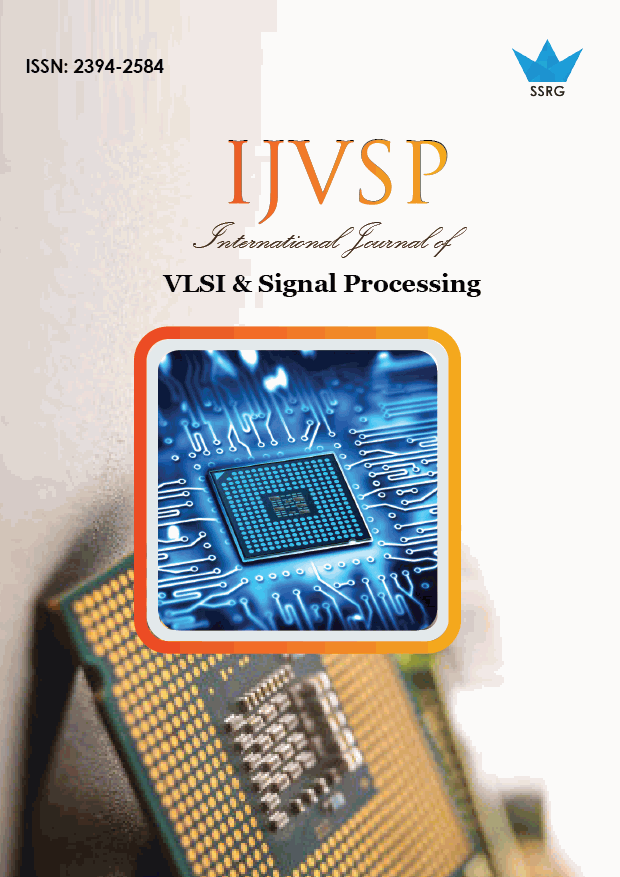An effective implementation of SOL’s technique for power and coding efficient VLSI architecture in DSRC applications

| International Journal of VLSI & Signal Processing |
| © 2016 by SSRG - IJVSP Journal |
| Volume 3 Issue 3 |
| Year of Publication : 2016 |
| Authors : Mr.Ravi Varma Nadimpalli and Mrs.S.Jyothi |
How to Cite?
Mr.Ravi Varma Nadimpalli and Mrs.S.Jyothi, "An effective implementation of SOL’s technique for power and coding efficient VLSI architecture in DSRC applications," SSRG International Journal of VLSI & Signal Processing, vol. 3, no. 3, pp. 15-21, 2016. Crossref, https://doi.org/10.14445/23942584/IJVSP-V3I6P101
Abstract:
An implementation of similarity oriented logic simplification (SOLS) technique is proposed in this project for effective utilization of VLSI architecture by overcoming the limitations that are encountered in FMO and Manchester codes. FMO codes and Manchester codes are widely used in Dedicated Short Range Communication (DSRC) applications. These codes are adapted to accomplish dc-balance and also to enhance the reliability of the signals. FMO and Manchester codes have number of components which limits the potential to design a fully reused VLSI architecture for both. The Dedicated Short Range Communication (DSRC) is an emerging technique; it is employed in one way or two way short ranges to medium range wireless communication purpose. DSRC is vital in many real time applications such as safety application commercial vehicle application emergency warning system for vehicle and intersection collision avoidance etc. With the use of proposed SOL’S technique 100% hardware utilization rate was attained for both FM0 and Manchester encodings. The power consumption, operation frequencies and core circuit area utilizations will be improved to a greater extent when compared with the existing works. Performance evaluation will be carried out on post layout stimulation in Taiwan Semiconductor Manufacturing Company (TSMC) 0.18-μm 1P6M CMOS technology. This projects not only makes use of VLSI architecture effectively, but it also show cases the efficient performance of the proposed techniques at reduced cost. This system also and supports the DSRC standards of many leading nations.
Keywords:
Dedicated short-range communication (DSRC), FM0, Manchester, VLSI.
References:
[1] Yu-Hsuan Lee, Member, IEEE, and Cheng-Wei Pan, ―Fully Reused VLSI Architecture of FM0/Manchester Encoding Using SOLS Technique for DSRC Applications, IEEE Transactions on Very Large Scale Integration (VLSI) Systems.
[2] F. Ahmed-Zaid, F. Bai, S. Bai, C. Basnayake, B. Bellur, S. Brovold, et al., ―Vehicle safety communications— Applications (VSC-A) final report, U.S. Dept. Trans., Nat. Highway Traffic Safety Admin., Washington, DC, USA, Rep. DOT HS 810 591, Sep. 2011.
[3] J. B. Kenney, ―Dedicated short-range communications (DSRC) standards in the United States, Proc. IEEE, vol. 99, no. 7, pp. 1162–1182, Jul. 2011.
[4] J. Daniel, V. Taliwal, A. Meier, W. Holfelder, and R. Herrtwich, ―Design of 5.9 GHz DSRC-based vehicular safety communication, IEEE Wireless Commun. Mag., vol. 13, no. 5, pp. 36–43, Oct. 2006.
[5] P. Benabes, A. Gauthier, and J. Oksman, ―A Manchester code generator running at 1 GHz, in Proc. IEEE, Int. Conf. Electron., Circuits Syst., vol. 3. Dec. 2003, pp. 1156–1159.
[6] A. Karagounis, A. Polyzos, B. Kotsos, and N. Assimakis, ―A 90nm Manchester code generator with CMOS switches running at 2.4 GHz and 5 GHz, in Proc. 16th Int. Conf. Syst., Signals Image Process., Jun. 2009, pp. 1–4.
[7] Y.-C. Hung, M.-M. Kuo, C.-K. Tung, and S.-H. Shieh, ―High-speed CMOS chip design for Manchester and Miller encoder, in Proc. Intell. Inf. Hiding Multimedia Signal Process., Sep. 2009, pp. 538–541.
[8] M. A. Khan, M. Sharma, and P. R. Brahmanandha, ―FSM based Manchester encoder for UHF RFID tag emulator, in Proc. Int. Conf. Comput., Commun. Netw, Dec. 2008, pp. 1– 6.
[9] M. A. Khan, M. Sharma, and P. R. Brahmanandha, ―FSM based FM0 and Miller encoder for UHF RFID tag emulator, in Proc. IEEE Adv. Comput. Conf., Mar. 2009, pp. 1317– 1322.
[10] J.-H. Deng, F.-C. Hsiao, and Y.-H. Lin, ―Top down design of joint MODEM and CODEC detection schemes for DSRC coded-FSK systems over high mobility fading channels, in Proc. Adv. Commun. Technol.Jan. 2013, pp. 98–103.
[11] I.-M. Liu, T.-H. Liu, H. Zhou, and A. Aziz, ―Simultaneous PTL buffer insertion and sizing for minimizing Elmore delay, in Proc. Int. Workshop Logic Synth., May 1998, pp. 162– 168.
[12] H. Zhou and A. Aziz, ―Buffer minimization in pass transistor logic, IEEE Trans. Comput. Aided Des. Integr. Circuits Syst., vol. 20, no. 5, pp. 693–697, May 2001.

 10.14445/23942584/IJVSP-V3I6P101
10.14445/23942584/IJVSP-V3I6P101